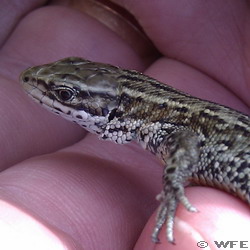
Common lizard during translocation
WFE works with developers to ensure that appropriate and cost-effective measures to reduce or remove negative impacts on biodiversity are incorporated during the project planning and design. We use the mitigation hierarchy as specified in CIEEM guidance – Avoid, Mitigate, Compensate, Enhance. These principles are then applied during the project construction and operation. Construction Environment Management Plans (CEMP) and Landscape and Ecology Management Plans (LEMP) often help to steer mitigation efforts.
The WFE team has comprehensive experience of mitigation projects for protected species in England, including mitigation for bats, great crested newts, reptiles, breeding birds, natterjack toads, badgers and water voles. Applying mitigation or compensation can sometimes be complicated and costly, but WFE works hard to find the most effective and practical solutions for species, habitats and development.
WFE has a 100% success rate for European Protected Species Licence applications.
Mitigation Services
- Reptile and amphibian translocation and exclusion fencing
- Mammal mitigation (water vole, otter and badger)
- Installation and siting of nest and roost boxes
- Habitat manipulation
- EPS licences (bats, great crested newts and natterjack toad)
- Badger mitigation licences
- Construction Environment Management Plans (CEMP) and Landscape and Ecology Management Plans (LEMP) to BS42020
- Post-mitigation species and habitat monitoring
- Ecological Clerk of Works
- Watching brief services
WFE also provide advice on Ecological Enhancement and Biodiversity Net Gain.
Project Examples
Ecological mitigation for a coastal grassland site
A brownfield site in North Norfolk is planned to accommodate a small housing development. It was surveyed by WFE and found to have a good quality semi-improved coastal-type grassland in…
